
The Effects of Artificial Light Sources on Lettuce Seedling Vigor and Growth
Ⓒ The Korean Environmental Sciences Society. All rights reserved.
This is an Open-Access article distributed under the terms of the Creative Commons Attribution Non-Commercial License (http://creativecommons.org/licenses/by-nc/3.0) which permits unrestricted non-commercial use, distribution, and reproduction in any medium, provided the original work is properly cited.
Abstract
The aim of this study was to investigate the effects of artificial light sources on the germination and seedling vigor of lettuce, aiming to identify the optimal artificial light source for producing high-quality seedlings. Lettuce cultivar of 'Tomalin' and 'Seonpunggold' exhibited the highest seed emergence in the Metal halide(MH) lamp and High-pressure sodium(HPS) lamp treatment group, while the emergence rate parameter, T50, was the fastest in the HPS lamp treatment group. Both cultivars showed good growth characteristics such as number of leaves, root length, and stem diameter under RGB-LED, and their seedling vigor was excellent as well. The plant height was smallest in the Red + Green + Blue LED treatment, but the leaves were round and thick, resulting in higher biomass and dry weight. Single light sources of Red LED and Blue LED led to reduced growth compared with that under the mixed light treatments. Chlorophyll content in lettuce varied with the type of artificial light, with both cultivars exhibiting the highest chlorophyll content in the Red + Green + Blue LED treatment. The most suitable artificial light for lettuce seedling growth was the Red + Green + Blue LED treatment.
Keywords:
Artificial light, Emergence, Growth, Leaf area index, Light emitting diode1. Introduction
Lettuce is rich in fiber, vitamins, and minerals, making it beneficial for patients with constipation and anemia, and it holds the largest market share among all leafy vegetables (RDA, 2018). In 2022, the cultivation area of lettuce in South Korea was 3,913 hectares, with an annual production of 97,137 tons (KOSIS, 2022).
Lettuce is a cold-season crop with optimal growth temperatures ranging from 15 to 20℃. When temperatures exceed 30℃, both germination and leaf development cease, and nutrient absorption decrease. As a result, during the hot summer season, lettuce prices often surge due to the unfavorable conditions for its growth.
In a plant factory, environmental conditions such as temperature, light, CO2, and nutrient solution are artificially controlled, allowing plants to be continuously produced automatically regardless of season or location (Lee et al., 2022). This represents an evolved cultivation system compared to traditional greenhouses, which provide only limited control over external factors (Lee, 2019).
Crop cultivation relies significantly on the cultivation environment, with considerable research focusing on artificial lighting in plant factories (Um et al., 2010; Lee et al., 2014; Uoon and Cho, 2019). Light is a crucial environmental factor involved in photosynthesis and morphogenesis of plants (Ma et al., 2021).
In plant factories, artificial lighting is used to supply insufficient natural light, while in facility cultivation, artificial lighting is utilized to enhance photosynthesis, particularly as daylight shortens from autumn onwards.
However, the type of artificial lighting used in crop cultivation has different effects on plant growth. Metal halide lamps, for example, distribute wavelengths across the visible spectrum, making them effective for plant growth, but they have disadvantages such as low luminous efficiency and short lifespan. On the other hand, fluorescent lamps are inexpensive but have lower luminous efficiency and a limited effective spectrum for photosynthesis (Park et al., 2011).
LEDs have the advantage of high efficiency, long lifespan, and the ability to easily create desired light quality. However, they are more expensive compared to other lighting options. Thus, each type of lighting has its own advantages and disadvantages, and the growth response of crops varies depending on the different wavelengths (Dougher and Bugbee, 2001; Kim et al., 2004).
This study was conducted to determine the effects of artificial light sources used for illumination in plant factories and facility cultivation on the germination and seedling growth of lettuce.
2. Materials and Methods
2.1. Crop cultivation conditions
The lettuce cultivars used in this experiment were 'Tomalin' (Kwonnong Seed Co.) and 'Seonpunggold' (Kwonnong Seed Co.). The experiment was conducted in a Venlo-type glass greenhouse with a floor area of 40 m2 located at Pusan National University.
The seeds of 'Tomalin' and 'Seonpunggold' were sown at a rate of 50 seeds per plug tray with 105 cells, repeated three times. The growing medium used was horticultural soil (Farmhannog, Seoul, Korea). Throughout the cultivation period, the day and night temperatures in the greenhouse were maintained at 20°C. To ensure proper temperature management during the experimental period, a temperature and humidity recorder (TR-72Ui, TSD Corporation, Japan) was installed in the center of the greenhouse from October 24th to November 13th to measure and collect temperature and humidity data.
2.2. Artificial light source process
The artificial light sources used in this experiment were a 400W high-pressure sodium lamp (HPS Ike-Nhip_400W, Il Kwang Electric Co., Ltd., Korea), a 175W metal halide lamp (MH Geolighting, Korea), red LED lights (R-L, Parus, Korea), blue LED lights (B-L, Parus, Korea), a combination of red + green + blue LED lights (RGB-L, D&W, Korea), and a combination of red + green + blue + far-red LED lights(RGBFR-L, D&W, Korea), all in bulb form.
The types of LED lights used were R-L(630 nm, R), B-L(450 nm, B), RGB-L(R:G:B=6.9:1:2.1, RGB), and RGBFR-L(R:G:B:FR=3.8:3.2:1.8:1.2, RGBFR). The LED lights were installed vertically at a height of 90 cm above the plug boards for seedlings and illuminated continuously for 24 hours. The control group was grown using natural sunlight.
The light intensities for each artificial light source were as follows: HPS lamp: 45 μmol·m-2·s-1, MH lamp: 14 μmol·m-2·s-1, R-L: 153 μmol·m-2·s-1, B-L: 149 μmol·m-2·s-1, RGB-L: 58 μmol·m-2·s-1, RGBFR-L: 91 μmol·m-2·s-1. The control group received natural sunlight with an intensity of 77 μmol·m-2·s-1.

B-L, HPS, MH, R-L, RGB-L, FGBFR-L artificial light resource treatments during the experiment periods
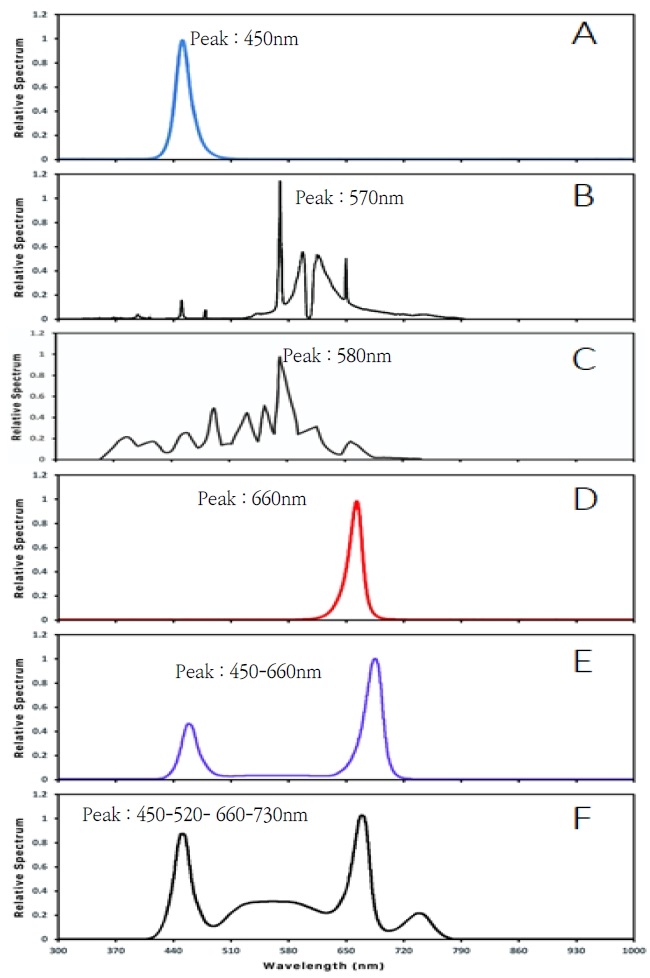
Light spectral distribution of artificial light source. A; B-L, B; HPS, C; MH, D; R-L, E; RGB-L, F;RGBFR-L.
Lux values for each light source were measured at three points on the seedling plug tray using a lux meter (ANA-F9, Tokyo Photo-Electric CO. LTD, Japan), and the average value was calculated. The lux value for the control group represents the measurement taken at 12:30.
2.3. Testing of seed germination rate by artificial light treatments
The study aimed to investigate the impact of artificial light sources on the seedling emergence rate and the speed of the seedling emergence. The speed of the seedling emergence was assessed by determining the time required for 50% germination, known as T50, relative to the final germination rate. The evaluation was conducted daily for seven days following sowing, and the emergence was determined based on the emergence of cotyledons above the soil surface. T50 was calculated by using the following formula.
- N : Sum of the number of seeds that emerged by the emergence survey deadline
- Ni: Sum of the number of seeds that emerged up to 50% of N
- Nj : Sum of the number of seeds that emerged immediately after 50% for N
- Ti : Appearance period until Ni
- Tj : Appearance period until Nj
2.4. Testing the seedling vigor by artificial light source treatments
Testing the seedling vigor included assessments on the 10th, 15th, and 20th days after sowing. The evaluated parameters consisted of number of leaves, leaf area, leaf length, leaf width, leaf shape index, plant height, root length, stem diameter, fresh weight, dry weight, and relative growth rate. Stem diameter was measured using a Vernier caliper (CD-15CP, Mitutoyo Co., Japan) on the thickest part of the stem, and leaf shape index was calculated by dividing leaf length by leaf width.
2.5. Testing chlorophyll content in lettuce seedlings by artificial light treatments
To assess the quality of seedlings, chlorophyll content was measured on days 10, 15, and 20 after sowing. The measurement involved using a chlorophyll meter (SPAD-502, Minolta Co., Ltd., Japan) to take readings at three points on the third fully expanded normal leaf, and the average value was recorded.
2.6. Statistical analysis
Statistical analysis was conducted by using the SAS program (Version SAS 9.4, SAS Institute Inc., Cary, NC, USA), and Duncan's multiple test was performed at a 95% confidence level.
3. Results and Discussions
3.1. The effect of artificial light sources on lettuce seedling emergence rate
Table 2 presents the results of investigating the germination rate of lettuce seeds under various artificial light sources.

Effect of artificial light source on percent emergence and days to 50% of the final emergence percentage(T50) of lettuce at 20℃ in greenhouse
Most horticultural crop seeds are capable of germination regardless of light, but photodissociative seed require light for germination. Lettuce has photodissociative seeds, and germination is promoted in red light (660 nm) while it is inhibited in far-red light (730 nm).
For both 'Tomalin' and 'Seonpunggold' cultivars, the germination rate was highest under MH at 97.3% and 98.7%, respectively, in case of ‘Seonpunggold’ cultivar germination rate under HPS was equal to MH. On the other hand, T50, the indication of the germination speed, was fastest under HPS at 2.75 days and 2.57 days, respectively (Table 2).
'Tomalin' exhibited the lowest germination rate under B-L(Blue LED), while 'Seonpunggold' had the longest T50 of 4.09 days under B-L, indicating an extended germination period. Taking into account the findings of the prior study (Cho et al., 2008), which demonstrated notable suppression of germination in rapeseed under B-L treatment, our study's results suggest that light quality indeed affects the germination of photodissociative seeds. Specifically, B-L treatment can be concluded to inhibit germination.
'Seonpunggold' showed a germination rate of over 90% five days after sowing, regardless of the light quality of the artificial light source. Germination speed varied depending on the light quality, with rapid germination occurring under HPS, while B-L resulted in the slowest emergence speed.
3.2. The effect of artificial light sources on lettuce seedling vigor
Table 3 presents the application of various artificial light sources to observe the growth of lettuce, aimed at investigating their effects on seedling growth.

Effect of artificial light source on number of leaves, leaf area for various growth state of ‘Tomalin’ and ‘Seonpunggold’ lettuce at 20℃ in greenhouse
Both 'Tomalin' and 'Seonpunggold' cultivars showed the highest number of leaves under the RGB-L (Red + Green + Blue LED) treatment. On the 20th day after sowing, the number of leaves for 'Tomalin' was 6.3, and for 'Seonpunggold' it was 6.0 (Table 3). In contrast, in ‘Tomalin’ the number of leaves was the lowest under MH, R-L and B-L treatment at 4.0, whlie in ‘Seonpunggold’ the number of leaves was the lowest under M-H and B-L at 4.0, which is attributed to the insufficient light intensity of MH at 14 μmol·m-2·s-1 for lettuce growth.
Light intensity plays a crucial role in plant growth, and it has been reported that lettuce shows reduced leaf count and overall poor growth under fluorescent lamps with light intensity below 70 μmol·m-2·s-1 (Lee et al., 2010). And also, in cabbage, an increase in light intensity was associated with an increase in number of leaves and leaf area, resulting in improved growth (Son et al., 2012).
The leaf area of both 'Tomalin' and 'Seonpunggold' was highest under HPS, with RGBF-L statistically belonging to the top group as well.
These results are consistent with a previous study by Lee et al.(2014), which reported an increase in leaf area in plants treated with HPS artificial lighting.
Table 4 illustrates differences in leaf growth of 'Tomalin' based on the type of artificial lighting, as evidenced by variations in leaf length and width. On the 10th day after sowing, leaf expansion rates were slower in the B-L, R-L, and MH treatments. Additionally, both leaf length and leaf width tended to be higher in the artificial lighting treatment groups compared to the control group.

Effect of artificial light source on leaf length, leaf width for various growth state of ‘Tomalin’ and ‘Seonpunggold’ lettuce at 20℃ in greenhouse
The leaf length was the longest in the HPS treatment at 9.62 cm on the 20th day after sowing, while the leaf width was the longest in the RGBFR-L treatment at 2.65 cm. On the other hand, lettuce grown under R-L treatment had the shortest leaf length and leaf width.
Similarly, 'Seonpunggold' also showed differences in leaf length and leaf width depending on the type of artificial light source, and generally, the artificial light treatments resulted in better leaf growth compared to the control. On the 20th day after sowing, the lettuce's leaf length was the highest in the HPS(8.92 cm) and RGBFR-L(8.37 cm) treatment, while the leaf width was the highest in the RGB-L(3.72 cm) and RGBFR-L(3.53 cm) treatment.
Fig. 2 depicts the leaf shape index, which is calculated by dividing leaf length by leaf width, indicating the leaf's shape. On the 20th day after sowing, 'Tomalin' exhibited the highest leaf shape index under the R-L treatment, followed by the MH treatment. Conversely, for 'Seonpunggold', the highest leaf shape index was observed under the MH treatment, followed by the R-L treatment.

Effect of artificial light source on leaf shape index for 20 days growth of ‘Tomalin’ and ‘Seonpunggold’ lettuce at 20℃ in greenhouse. Artificial light source treatment B-L; Blue LED, HPS; High-pressure sodium lamp, MH: Metal halide lamp, R-L; Red LED, RGB-L; Red + Green + Blue LED, FGBFR-L; Red + Green + Blue + Far-Red LED. Vertical bars are means ± SE of three measurements. Means separation at P = 0.05 with Duncan's multiple range test.
These results are similar to the findings of Kim et al.(2017), where an increase in the proportion of B-L in mixed LED treatments resulted in a more rounded leaf shape. In this study, the Blue LED proportion in the RGB-L mixed light was 21%.
B-L is known to inhibit plant height growth (Rajapakse and Kelly, 1992), while R-L is reported to have a lower inhibitory effect on plant height growth under conditions without blue light (McMahon et al., 1991). However, Fig. 3 illustrates that in this study, both cultivars showed the lowest plant height growth under RGB-L conditions. This suggests that the inhibitory effect on plant height growth increases when various lights are mixed compared to single B-L.
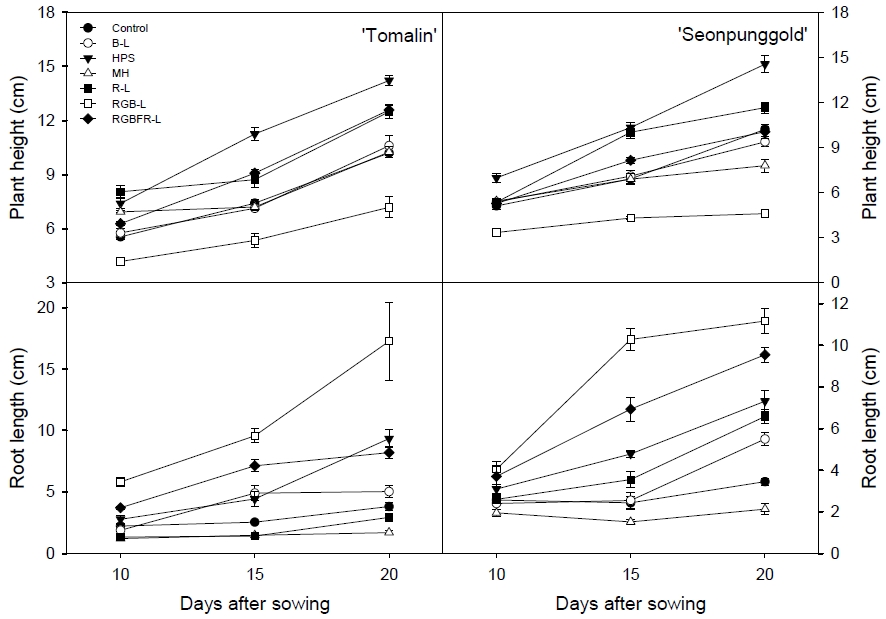
Effect of artificial light source on plant height and root length for 20 days growth of ‘Tomalin’ and ‘Seonpunggold’ lettuce at 20℃ in greenhouse. Vertical bars are means ± SE of three replications.
On the other hand, when comparing single B-L and R-L treatments, both cultivars showed lower plant height growth in B-L treatment compared to R-L treatment. Root length was the longest in both cultivars under RGB-L treatment and the shortest under MH treatment.
Table 5 demonstrates that the stem diameter of both 'Tomalin' and 'Seonpunggold' cultivars was highest under RGB-L treatment, followed by RGBFR-L and HPS treatments. After 20 days of sowing, the stem diameter of 'Tomalin' was 1.42 mm under RGB-L treatment, which was more than twice as high as that in the control group. Similarly, the stem diameter of 'Seonpunggold' was 1.46 mm under RGB-L treatment, which was also more than twice as high as that in the control group. Conversely, under R-L, MH, and B-L treatments, the stem diameter was lower than that in the control group, at 0.68 mm. In 'Seonpunggold,' the stem diameter was lowest under MH treatment.

Effect of artificial light source on stem diameter for various growth state of ‘Tomalin’ and ‘Seonpunggold’ lettuce at 20℃ in greenhouse
Table 6 highlights that for 'Tomalin,' both fresh weight and dry weight exhibited a tendency to be highest under RGB-L treatment, followed by RGBFR-L and HPS treatments throughout the entire growth period. After 20 days of sowing, the fresh weight and dry weight of 'Tomalin' under RGB-L treatment were 1120.15 mg and 70.98 mg, respectively, which were more than three times higher than those in the control group, which were 211.04 mg and 23.95 mg, respectively.

Effect of artificial light source on fresh and dry weight for various growth state of ‘Tomalin’ lettuce at 20℃ in greenhouse
Table 7 illustrates that for 'Seonpunggold' as well, the fresh weight after 20 days of sowing under RGBFR-L and RGB-L treatments was 1456.48 mg and 1433.4 mg, respectively, which was more than seven times higher than that in the control group. Therefore, for both cultivars, the growth was best in the RGB-L and RGBFR-L mixed treatment groups.

Effect of artificial light source on fresh and dry weight for various growth state of ‘Seonpunggold’ lettuce at 20℃ in greenhouse
On the other hand, although leaf area, plant height, and overall growth were highest under HPS, the fresh weight, dry weight, and relative growth rate for both cultivars tended to be lower than those in the RGB-L and RGBFR-L mixed treatment groups (Table 7 and Fig. 5). Plants positioned under HPS and LED experience a slight increase in apiculus meristem temperature (Lee et al., 2014), and it is speculated that this increase in apiculus meristem temperature due to HPS lighting may have had some impact on seedling growth.
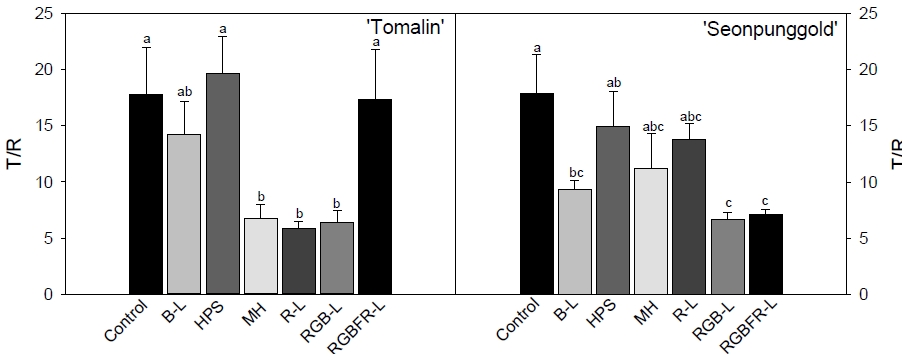
Effect of artificial light source on T/R for 20 days growth of ‘Tomalin’ and ‘Seonpunggold’ lettuce at 20℃ in greenhouse. Artificial light source treatment B-L; Blue LED, HPS; High-pressure sodium lamp, MH: Metal halide lamp, R-L; Red LED, RGB-L; Red + Green + Blue LED, FGBFR-L; Red + Green + Blue + Far-Red LED. Vertical bars are means ± SE of three measurements. Means separation at P = 0.05 with Duncan's multiple range test.
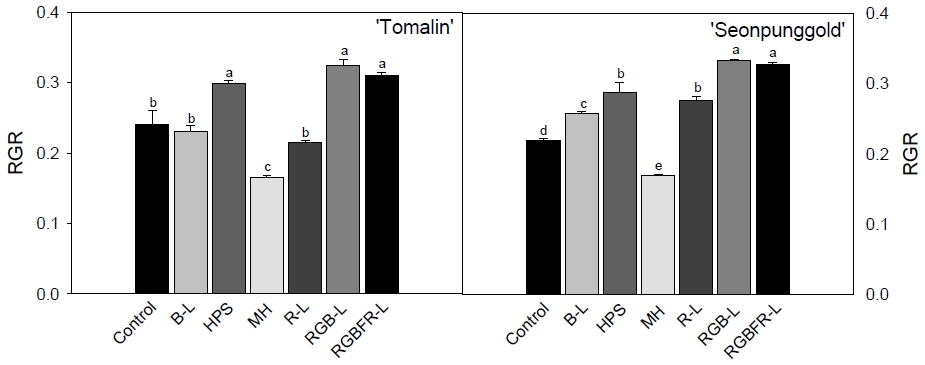
Effect of artificial light source on relative growth rate for 20 days growth of ‘Tomalin’ and ‘Seonpunggold’ lettuce at 20℃ in greenhouse. Artificial light source treatment B-L; Blue LED, HPS; High-pressure sodium lamp, MH: Metal halide lamp, R-L; Red LED, RGB-L; Red + Green + Blue LED, FGBFR-L; Red + Green + Blue + Far-Red LED. Vertical bars are means ± SE of three measurements. Means separation at P = 0.05 with Duncan's multiple range test.
In the case of single light sources like R-L and B-L, overall growth was inhibited compared to mixed light sources. This inhibition could be attributed to delayed plant growth under lower light intensities (Park et al., 2011; Kwon and Park, 2018). Therefore, it is interpreted that lettuce growth was suppressed in light treatments such as MH, R-L, and B-L, which relatively had lower light intensity compared to LED mixed light treatments, resulting in lower biomass production.
After 20 days post-seeding, the T/R ratio for both cultivars was highest in the control group and lowest in the RGB-L treatment. For lettuce, the criteria for high-quality seedlings include higher dry weight and lower T/R ratio, leaf area ratio (leaf area/leaf weight), and stem length (Kitaya et al., 1998). In the HPS treatment, although number of leaves and leaf area were high, biomass and plant weight were low, indicating a higher leaf area ratio.
In summary, both cultivars exhibited superior seedling growth in the RGB-L treatment, characterized by higher plant weight and lower shoot-to-root ratio(T/R), indicating better seedling quality. Following RGB-L, the RGBFR-L and HPS treatments showed the next best growth performances.
Fig. 5 illustrates the effect of artificial lighting on relative growth rate. In both cultivars, the relative growth rate was lowest in the MH treatment and highest in the RGB-L and RGBFR-L treatments. Additionally, for 'Tomalin', the relative growth rate was lower in the B-L and R-L treatments compared to the control group. It is known that an increase in light intensity leads to an increase in plant biomass and leaf expansion rate, thereby enhancing seedling quality (Jang et al., 2017). Conversely, a decrease in light intensity results in reduced vigor metrics such as leaf area ratio and leaf area index for seedlings (Kwack and An, 2021).
In this study, it was observed that the lower light intensity in the MH treatment resulted in reduced plant biomass, as indicated in Tables 6-7. Consequently, the relative growth rate was also lower in the MH treatment compared to other light treatments.
3.3. Effect of artificial lighting on the chlorophyll content of lettuce
Table 8 examines the effect of various artificial lighting treatments on chlorophyll content in the cultivation of lettuce. For both 'Tomalin' and 'Seonpunggold' cutivars, chlorophyll content was highest under RGB-L lighting throughout the entire growth period.

Effect of artificial light source on chlorophyll for various growth state of ‘Tomalin’ and ‘Seonpunggold’ lettuce at 20℃ in greenhouse
‘Tomallin' exhibited a trend of decreasing chlorophyll content initially under HPS treatment, followed by an increase as the growth period progressed, while 'Seonpunggold' showed a continuous decrease in chlorophyll content. Conversely, under MH treatment, chlorophyll content was lower throughout the entire growth period compared to other artificial lighting sources. This is interpreted as being due to the lower light intensity of MH (Kim et al., 2018), which led to a reduction in photosynthetic activity and consequently inhibited growth.
In 'Seonpunggold', the chlorophyll content of plants grown under B-L and R-L treatments for 20 days after sowing was 11.30 SPAD and 11.33 SPAD, respectively, which were higher than that of the control group. A similar trend was observed in 'Tomalin' as well. Kasim and Kasim(2017) reported that chlorophyll content varies with light quality, and chlorophyll content was higher under single B-L and R-L treatments compared to the control group. These findings suggest that the light quality of artificial lighting influences chlorophyll content, with the highest content observed under RGB-L treatment, which combines red, green, and blue LEDs.
Fig. 6 and Fig. 7 demonstrate that in visual evaluation, both cultivars displayed a purplish coloration of leaves under RGB-L treatment. Also, under RGB-L treatment, although the seedlings had short plant height, the leaves were round-shaped, thick, and had short hypocotyl lengths, indicating overall excellent seedling vigor.
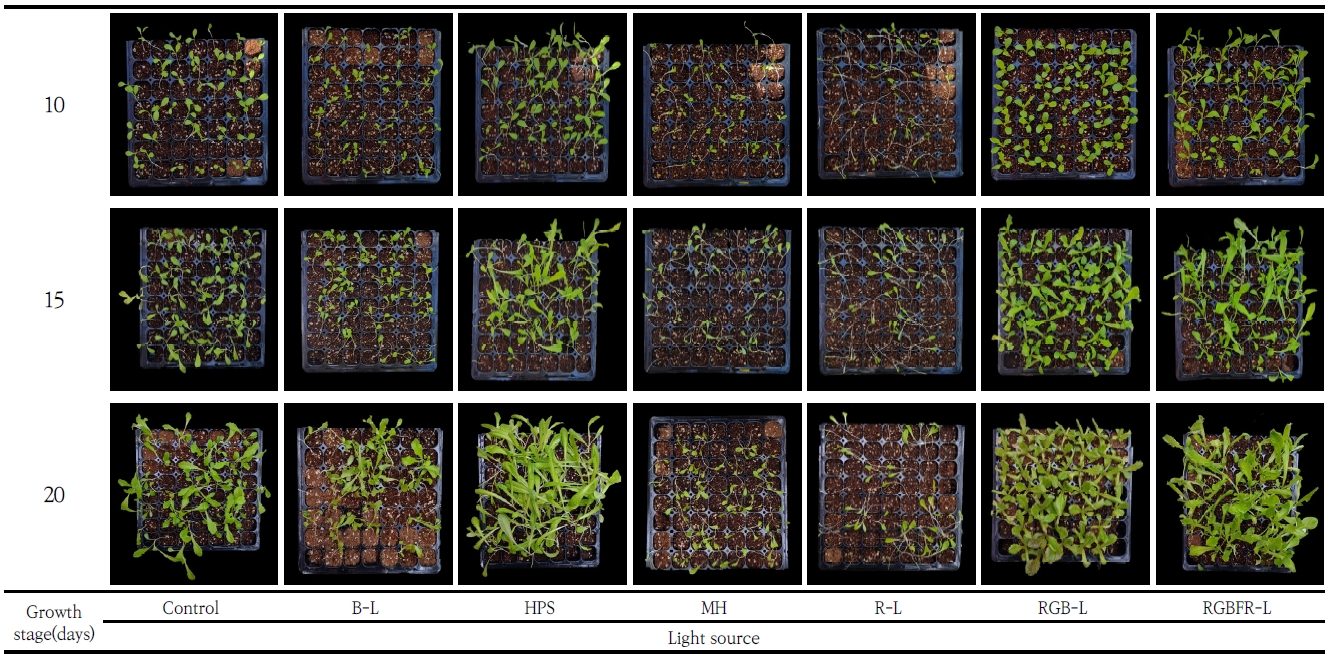
Changes in growth of ‘Tomalin’ lettuce seedling by different light source treatment 10, 15 and 20 days after transplanting at 20℃ in greenhouse. Artificial light source treatment B-L; Blue LED, HPS; High-pressure sodium lamp, MH: Metal halide lamp, R-L; Red LED, RGB-L; Red + Green + Blue LED, FGBFR-L; Red + Green + Blue + Far-Red LED.
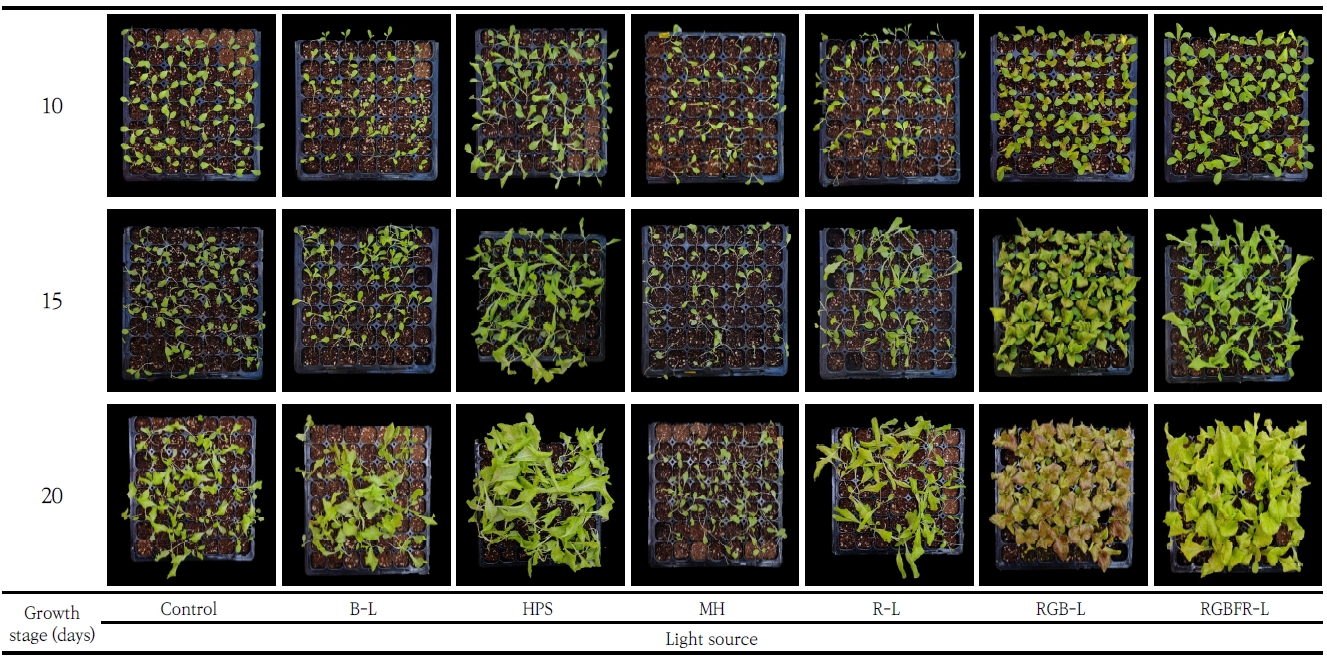
Changes in growth of ‘Seonpunggold’ lettuce seedling by different light source treatment 10, 15 and 20 days after transplanting at 20℃ in greenhouse. Artificial light source treatment B-L; Blue LED, HPS; High-pressure sodium lamp, MH: Metal halide lamp, R-L; Red LED, RGB-L; Red + Green + Blue LED, FGBFR-L; Red + Green + Blue + Far-Red LED.
In RGBFR-L and HPS treatments as well, the leaf area was broader, and seedling vigor was superior compared to the control group. Conversely, in treatments with single artificial light sources such as B-L, R-L, and MH, the seedling vigor was inferior to the control group (Fig. 6 and Fig. 7).
4. Conclusion
This study aimed to investigate the effects of artificial light sources on the seedling emergence and seedling vigor of lettuce, with the goal of identifying the optimal artificial light source for producing high-quality seedlings.
'Tomalin' and 'Seonpunggold' exhibited the highest germination rates under MH treatment, while the T50, representing the germination speed, was fastest under HPS treatment. Both 'Tomalin' and 'Seonpunggold' had the highest number of leaves under RGB-L (Red + Green + Blue LED) treatment. Stem diameter was also highest under RGB-L treatment for both cultivars, followed by RGBFR-L and HPS treatments. Conversely, under single light sources such as R-L, MH, and B-L, overall growth parameters including stem diameter were lower compared to mixed light source treatments. Relative growth rates were lowest under MH treatment and highest under RGB-L and RGBFR-L treatments.
The chlorophyll content in lettuce varied depending on the type of artificial light source, with both cultivars showing the highest chlorophyll content under RGB-L (Red + Green + Blue LED) treatment. To enhance lettuce seedling emergence and promote seedling growth, it was more effective to use a combination of red + blue + green + far-red lights rather than single light sources. The most suitable artificial light source for lettuce seedling growth was RGB-L (Red + Green + Blue LED) treatment, followed by RGBFR-L.
Acknowledgments
This work was supported by a 2 year research grant of Pusan National University.
REFERENCES
- Cho, J. Y., Son, D. M., Kim, J. M., Seo, B. S., Yang, S. Y., Kim, B. W., Heo, B. G., 2008, Effects of various LEDs on the seed germination, growth and physiological activities of rape(Brassica napus) sprout vegetable, Korean J. Plant Res., 21, 304-309.
-
Dougher, T. A., Bugbee, B., 2001, Differences in the response of wheat, soybean and lettuce to Reduced blue radiation, Phytochem Photobiol., 73, 199-207.
[https://doi.org/10.1562/0031-8655(2001)073<0199:DITROW>2.0.CO;2]

- Jang, E. H., Seo, H. T., Kim, Y. J., Won, J. H., Park, K. J., Bang, S. B., 2017, The growth responses of fresh cut lettuces to light quality and light intensity in the plant factory using artificial lights, Hortic. Sci. Technol., 35-58.
-
Kasim, M. U., Kasim, R., 2016, While continuous white LED lighting increases chlorophyllcontent (SPAD), green LED light reduceds the infection rate of lettuce during storage and shelf-life conditions, J. Food processing and preservation, 41, 6.
[https://doi.org/10.1111/jfpp.13266]

-
Kim, H. G., Lee, J. S,, Kim, Y. H., 2018, Chlorophyll fluorescence, chlorophyll content, graft-taking, and growth of grafted cucumber seedlings affected by photosynthetic photon flux of LED lamps, Protected Horticulture and Plant Factory, 27, 231-238
[https://doi.org/10.12791/KSBEC.2018.27.3.231]

-
Kim, H. H,, Goins, G. D., Wheller, R. M., Sager, J. C., 2004, Green-light supplementation for enhanced lettuce growth under red- and blue-light-emitting diodes, HortScience, 39, 1617-1622.
[https://doi.org/10.21273/HORTSCI.39.7.1617]

-
Kim, S. J., Bok, G. J., Lee, G. J., Park, J. S., 2017, Growth characteristics of Lettuce under different frequency of pulse lighting and RGB Ratio of LEDs, Protected Horticulture and Plant Factory, 26, 123-132.
[https://doi.org/10.12791/KSBEC.2017.26.2.123]

-
Kitaya, Y., Niu, G., Kozai, T., Ohashi, M., 1998, Photosynthetic photon flux, photoperiod, and CO2 concentration affect growth and morphology of lettuce plug transplants, HortScience, 33, 988-991.
[https://doi.org/10.21273/HORTSCI.33.6.988]

- KOSIS, Accessed 02 december 2022, https://kosis.kr, .
-
Kwack, Y., An, S., 2021, Changes in growth of watermelon scions and rootstocks grown under different air temperature and light intensity conditions in a plant factory with artificial lighting, J.Bio-Environ. Control, 30, 133-139.
[https://doi.org/10.12791/KSBEC.2021.30.2.133]

-
Kwon, K. J., Park, B. J., 2018, Effect of light intensity on the growth responses of three woody plants for indoor landscaping, J. Kor, Ins. Landscape Archite., 46, 1-8.
[https://doi.org/10.9715/KILA.2018.46.1.001]

-
Lee, J. E., Kim, H. D., Lee, G. B., Kang, J. S., 2022, Effects of carbon dioxide application on the plant growth and productivity of strawberry in a greenhouse, J. Enviro. Sci. Inter., 31, 951-958.
[https://doi.org/10.5322/JESI.2022.31.11.951]

- Lee, J. G., Oh, S. S., Cha, S. H., Jang, Y. A., Kim, S. Y., Um, Y. C., Cheon, S. R, 2010, Effects of red/blue light ratio and short-term light quality conversion on growth and anthcyanin contents of baby leaf lettuce, J. Bio-Environ. Control, 19, 351-359.
-
Lee, J. W., Kim, H. C,, Jeong, P. H,, Ku, Y. G,, Bae, J. H,, 2014, Effects of supplemental lighting of high pressure sodium and lighting emitting plasma on growth and productivity of paprika during low radiation period of winter season, Kor. J. Hort. Sci. Technol., 32, 346-352.
[https://doi.org/10.7235/hort.2014.14029]

- Lee, K. H., 2019, Trends and prospects of future agricultural technology, https://www.ibric.org, .
-
Ma, Y., Xu, A., Cheng, Z. M., 2021, Effects of light emitting diode lights on plant growth, development and traits a meta-analysis, Horticultural Plant, J., 7, 552-564.
[https://doi.org/10.1016/j.hpj.2020.05.007]

-
McMahon, M. J., Kelly, J. W., Decoteau, D. R., 1991, Growth of Dendranthema × grandiflorum (Ramat.) kitamura under various spectral filters, J. Amer. Soc. Hort. Sci. 116, 950-954.
[https://doi.org/10.21273/JASHS.116.6.950]

- Park, J. S., Im, J. T., Yoon, S. W., Hwangbo, J. K., 2011, Effects of R-L/B-L LED light ratio on seedling growth of several horticultural plants, Kor. J. Hort. Sci. Technol., 29- 84.
-
Rajapakse, N. C., Kelly, J. W., 1992, Regulation of chrysanthemum growth by spectral filters, J. Amer. Soc. Hort. Sci., 117, 481-485.
[https://doi.org/10.21273/JASHS.117.3.481]

- RDA, 2018, Lettuce, Agricultural technology guide, 160, 17.
-
Son, K. H., Oh, M. M., 2015, Growth, photosynthetic and antioxidant parameters of two lettuce cultivars as affected by red, green, and blue light-emitting diodes, Hortic. Environ. Biotechnol., 56, 639-653.
[https://doi.org/10.1007/s13580-015-1064-3]

- Um, Y. C., Oh, S. S., Lee, J. G., Kim, S. Y., Jang, Y. A., 2010, The development of container-type plant factory and growth of leafy vegetables as affected by different light source, J. Bio-Environ. Con., 19, 333-342.
-
Uoon, C. I., Co, Y. Y., 2019, Optimal planting density on growth and quality characteristics of kohlrabi in a closed-type plant factory system, Protected Horticulture and Plant Factory, 28, 104-109.
[https://doi.org/10.12791/KSBEC.2019.28.2.104]

Department of Horticulture Bioscience, Pusan National Universityevery921004@naver.com
Department of Horticulture Bioscience, Pusan National Universityjujujjk5734@naver.com
Department of Horticulture Bioscience, Pusan National Universitydanggeun00@gmail.com
Department of Horticulture Bioscience, Pusan National Universitybije@pusan.ac.kr
Department of Horticulture Bioscience, Pusan National Universitykangjs@pusan.ac.kr